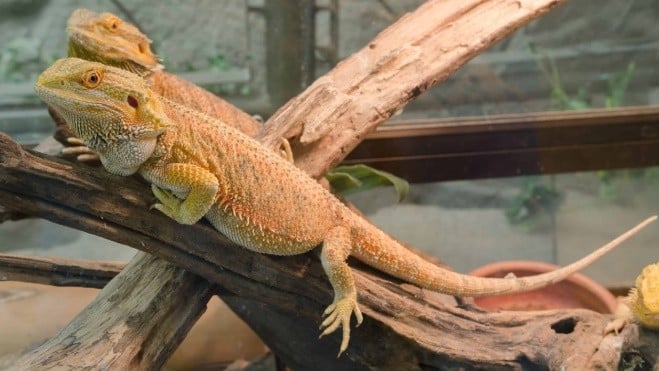No. Ideally, do not house them together unless. Even in the wild, beardies live a solitary lifestyle. Therefore, they will flourish well alone with only your company.
The only times they may have contact is when two males are competing for one male or as they mate or if they share common resources such as basking or foraging areas. Afterward, each goes their way without any long-term emotional connection.

Some of the reasons why you should not house these pets together include the following:
They will fight
Since adult bearded dragons are territorial and maintain a social hierarchy. Housing them together may make them fight as each of them tries to defend his turf, especially males.
When housed together, males may also fight over females while some females fight as a way of keeping pecking order.
During these fights, they may bite each other’s tail, nails, or some may die. Remember, a bearded dragon’s tail doesn’t grow back of bitten.
Finally, baby bearded dragons may accidentally bite each other’s toes and nails as they compete for food or if they mistake the tail and toes as live food. Separate babies once they are 2-4 weeks old.
They will breed
Keeping a male and a female will make them reproduce. One female beardie lays about 20 eggs. If this happens, freeze the eggs and dispose of them. Don’t let them hatch unless you are an expert or a breeder.
Even if you want to breed your bearded dragons, something that happens immediately after brumation, you don’t house them together. Instead, let them make and keep each separately.
Competition for resources
If housed together, larger males will deter smaller beardies or juveniles from eating, drinking, or basking. Something will affect their health. This is the same case of putting an adult and a baby beardie together.
The subservient deterred from basking under heat lamps or UV light exposure may cause metabolic bone disease besides starvation and weight loss.
Cross infection in case one is ill
Finally, in case one has a contagious disease or infection, housing them together will increase the chances of others getting the sickness.
What if they are peaceful?
However, some may co-exist peacefully and enjoy each other’s company, especially those that were hatched and grew together.
In such a case, ensure their vivarium is big enough to accommodate both of them. Ensure they have their separate space and don’t compete for water, food, basking area, and so on. You will also need to feed them separately.
Finally, ensure you always check them to ensure fighting and aggression doesn’t occur and avoid putting a bearded dragon together with geckos or other reptiles.
Tank size for two bearded dragons
If you already know the right tank size for baby, juvenile, or adult bearded dragons, buying one for two should not be a daunting task. An ideal tank should be at least one and a half times to twice the enclosure you buy for one beardie.
This extra size is to accommodate for supplies for the second beardie, such as basking platform, hammocks, climbing branches, hiding boxes, feeding and water bowls, and other décor and furniture.
Furthermore, you need UV lights and heat lamps that will illuminate the separate basking areas as this will avoid competition.
For instance, since each adult 75-120 gallons of space alone, make the size for two 15-2 times. Typically, a 100-150-gallon cage will be ideal.
Finally, even if they grew together, there is no guarantee that they will co-exist peacefully. Why? Since they grow at a different rate, soon they will start competing for the various resources available, weaker ones will be bullied and stressed.
